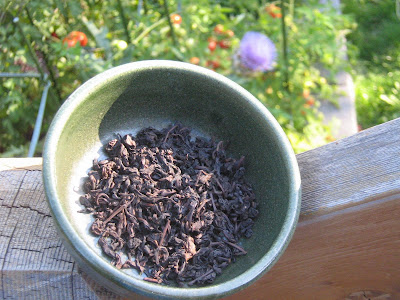 Some of the last summer tomatoes; the cute little green bowl was made by a friend--more of her work to come!
Some of the last summer tomatoes; the cute little green bowl was made by a friend--more of her work to come! This tea makes me second-guess my attitudes toward aged oolong. Labeled as 50's/60's, it's easily one of the oldest (if not the oldest) teas I've ever tasted, provided the age is accurate. Who really cares, though--it's about drinking experience and flavor, right? Despite my giddy anticipation, this tea was a winner in both respects. Every once in a great while I'll stumble on one of those cunning seductress teas--at first, the flavor just isn't there. "Looks like the storage took its toll on this one," I'll brashly quip, hoisting my trousers up with both thumbs for effect. After a few sips, though, it starts building, and after a handful of infusions the complexity can only be described as delightful--the tea tastes different, depending on the size of the sip, the temperature, the amount of air taken through the mouth and/or nose before and after swallowing, and the gan dances on with every breath. The flavor alternates between darkly floral and woody fruit, with only a hint of the humidity present in the 70's oolong from NadaCha and none of the whatever-it-is that makes the 90's baozhong from Hou De sort of unbearable after a couple cups. I'm not much on super-accurate flavor description (sorry, but most of the time identification of specific flowers, fruits or other plants would be specious coming out of my mouth, not to mention pretentious), but to me this tea is definitely of the same genre as those other two. That is, aged baozhong. I wish they still produced more baozhong this way--to me it's a lot more interesting than those green, green flowers-in-a-cup teas that seem to be winning all the competitions lately. I'm sure some of the deliciousness comes from the aging, too.
This tea makes me second-guess my attitudes toward aged oolong. Labeled as 50's/60's, it's easily one of the oldest (if not the oldest) teas I've ever tasted, provided the age is accurate. Who really cares, though--it's about drinking experience and flavor, right? Despite my giddy anticipation, this tea was a winner in both respects. Every once in a great while I'll stumble on one of those cunning seductress teas--at first, the flavor just isn't there. "Looks like the storage took its toll on this one," I'll brashly quip, hoisting my trousers up with both thumbs for effect. After a few sips, though, it starts building, and after a handful of infusions the complexity can only be described as delightful--the tea tastes different, depending on the size of the sip, the temperature, the amount of air taken through the mouth and/or nose before and after swallowing, and the gan dances on with every breath. The flavor alternates between darkly floral and woody fruit, with only a hint of the humidity present in the 70's oolong from NadaCha and none of the whatever-it-is that makes the 90's baozhong from Hou De sort of unbearable after a couple cups. I'm not much on super-accurate flavor description (sorry, but most of the time identification of specific flowers, fruits or other plants would be specious coming out of my mouth, not to mention pretentious), but to me this tea is definitely of the same genre as those other two. That is, aged baozhong. I wish they still produced more baozhong this way--to me it's a lot more interesting than those green, green flowers-in-a-cup teas that seem to be winning all the competitions lately. I'm sure some of the deliciousness comes from the aging, too.As far as the rest of the drinking experience is concerned, it's cake. One thing I do like about well-aged oolongs is that they're usually easy to brew, and you can usually keep coaxing flavor out of them with long steeps. The mouthfeel is great and slippery, especially for a roasted tea. Finally, the qi of this tea is great--mellowing, with a relaxing sort of cloudy buzzing feeling around the head and eyes--usually I only find this sort of qi in pu-erhs. I'm no expert on qi, nor am I especially sensitive to it, but if a tea gives me a pleasant feeling other than a straight-up caffeine buzz, I'm always appreciative. The cashed leaves are in pretty great shape, considering the tea is potentially twice as old as I am. It is so fascinating to me to hold and experience only lightly processed organic matter from such a long time ago, and the chance to compare the look, feel, and flavor of the leaves to recent teas is engrossing as well. This tea was a distinct privilege to try.

As for aged oolongs as a genre, I remain respectfully aloof. I've tasted proof that, done properly, aged oolong can present a drinking experience unique from both unaged oolong and aged pu-erh, but I've tasted much more proof that few people seem to know how to do it properly. If the amount of practically usable information (in English) about aging pu-erh is frustratingly incomplete, anecdotal, and old-wives'-tale-y, then the secrets of successful oolong aging are downright arcane. I won't be exhaustively picking over my available tea sources for aged teas, but I'll probably continue nosing about for teas I'd be willing to drink regularly, if all the elements line up correctly. Personally, I don't have any big plans to age any Taiwanese oolongs (I've got 4oz of Dong Ding jarred away), though I'm probably going to experiment with aging some Wuyi teas, just for fun. I've been enjoying reading everyone's posts about the Yunnan Sourcing tasting event--though it's a bit like reading reviews of a movie you didn't see, it's always fun to hear multiple opinions about the same teas, and hear how differently some people regarded each tea.































